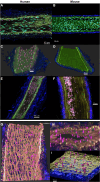Sickle Trait and Alpha Thalassemia Increase NOS-Dependent Vasodilation of Human Arteries Through Disruption of Endothelial Hemoglobin-eNOS Interactions
- PMID: 39633569
- PMCID: PMC11670920
- DOI: 10.1161/CIRCULATIONAHA.123.066003
Sickle Trait and Alpha Thalassemia Increase NOS-Dependent Vasodilation of Human Arteries Through Disruption of Endothelial Hemoglobin-eNOS Interactions
Abstract
Background: Severe malaria is associated with impaired nitric oxide (NO) synthase (NOS)-dependent vasodilation, and reversal of this deficit improves survival in murine models. Malaria might have selected for genetic polymorphisms that increase endothelial NO signaling and now contribute to heterogeneity in vascular function among humans. One protein potentially selected for is alpha globin, which, in mouse models, interacts with endothelial NOS (eNOS) to negatively regulate NO signaling. We sought to evaluate the impact of alpha globin gene deletions on NO signaling and unexpectedly found human arteries use not only alpha but also beta globin to regulate eNOS.
Methods: The eNOS-hemoglobin complex was characterized by multiphoton imaging, gene expression analysis, and coimmunoprecipitation studies of human resistance arteries. Novel contacts between eNOS and hemoglobin were mapped using molecular modeling and simulation. Pharmacological or genetic disruption of the eNOS-hemoglobin complex was evaluated using pressure myography. The association between alpha globin gene deletion and blood pressure was assessed in a population study.
Results: Alpha and beta globin transcripts were detected in the endothelial layer of the artery wall. Imaging colocalized alpha and beta globin proteins with eNOS at myoendothelial junctions. Immunoprecipitation demonstrated that alpha globin and beta globin form a complex with eNOS and cytochrome b5 reductase. Modeling predicted negatively charged glutamic acids at positions 6 and 7 of beta globin to interact with positively charged arginines at positions 97 and 98 of eNOS. Arteries from donors with a glutamic acid-to-valine substitution at beta globin position 6 (sickle trait) exhibited increased NOS-dependent vasodilation. Alpha globin gene deletions were associated with decreased arterial alpha globin expression, increased NOS-dependent vasodilation, and lower blood pressure. Mimetic peptides that targeted the interactions between hemoglobin and eNOS recapitulated the effects of these genetic variants on human arterial vasoreactivity.
Conclusions: Alpha and beta globin subunits of hemoglobin interact with eNOS to restrict NO signaling in human resistance arteries. Malaria-protective genetic variants that alter the expression of alpha globin or the structure of beta globin are associated with increased NOS-dependent vasodilation. Targeting the hemoglobin-eNOS interface could potentially improve NO signaling in diseases of endothelial dysfunction such as severe malaria or chronic cardiovascular conditions.
Keywords: alpha-Globins; alpha-Thalassemia; beta-Globins; hemoglobins; nitric oxide; nitric oxide synthase type III; sickle cell trait.
Conflict of interest statement
H.C.A., S.B., and P.C. are co-inventors on a patent held by the National Institute of Allergy and Infectious Diseases for structures and uses of beta globin mimetic peptides (PCT/US2023/065432). The other authors report no conflicts.
Figures







References
-
- Palmer R, Ferrige A, Moncada S. Nitric oxide release accounts for the biological activity of endothelium-derived relaxing factor. Nature. 1987;327:524–526. doi: 10.1038/327524a0 - PubMed
-
- Butler AR, Megson IL, Wright PG. Diffusion of nitric oxide and scavenging by blood in the vasculature. Biochim Biophys Acta. 1998;1425:168–176. doi: 10.1016/s0304-4165(98)00065-8 - PubMed
-
- Vaughn MW, Kuo L, Liao JC. Effective diffusion distance of nitric oxide in the microcirculation. Am J Physiol. 1998;274:H1705–H1714. doi: 10.1152/ajpheart.1998.274.5.H1705 - PubMed
-
- Rhodin JA. The ultrastructure of mammalian arterioles and precapillary sphincters. J Ultrastruct Res. 1967;18:181–223. doi: 10.1016/s0022-5320(67)80239-9 - PubMed
MeSH terms
Substances
Grants and funding
LinkOut - more resources
Full Text Sources

